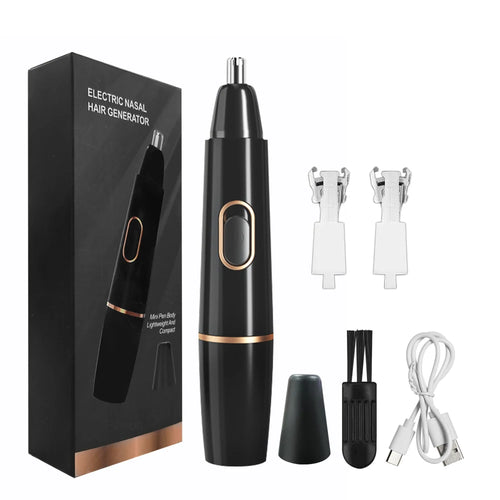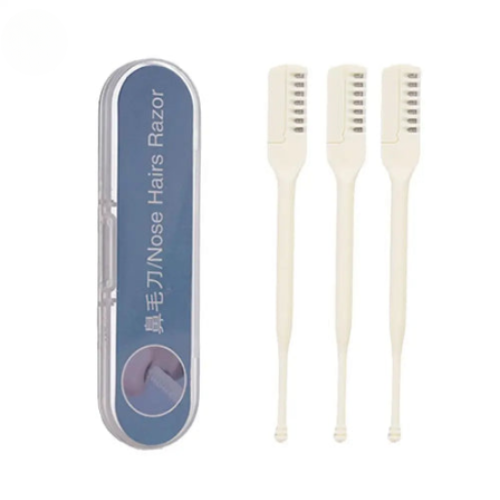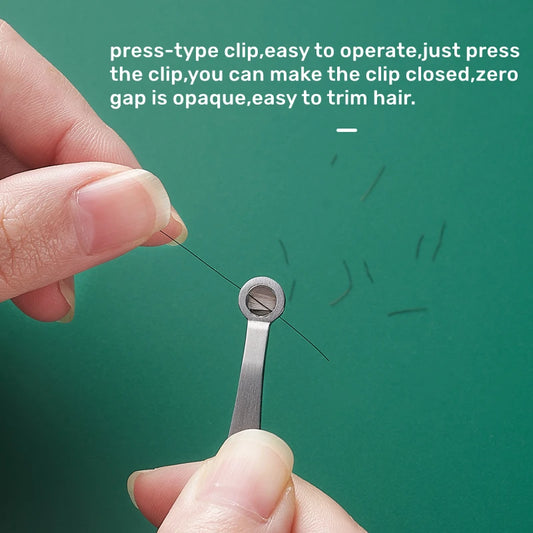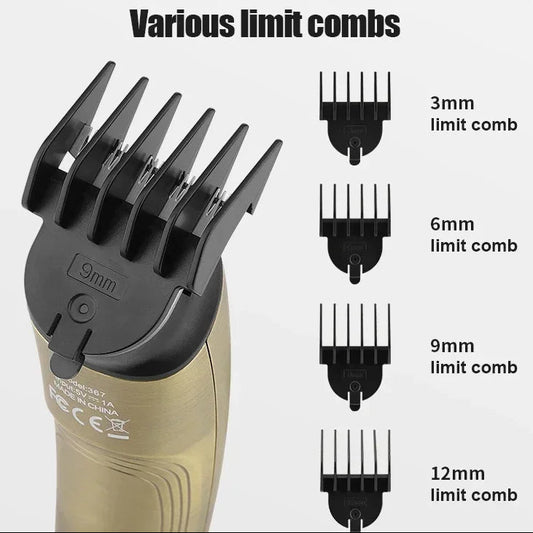-
Nose Wax Kit
Regular price From $19.76 USDRegular priceUnit price / per -
Electric Nose Hair Trimmer
Regular price $18.70 USDRegular priceUnit price / per -
Rechargeable Nose Hair Trimmer
Regular price From $75.42 USDRegular priceUnit price / per -
Electric Nose & Ear Hair Trimmer
Regular price $33.98 USDRegular priceUnit price / per -
Nose Hair Wax Kit For Men
Regular price $36.52 USDRegular priceUnit price / per -
Portable Nose Hair Trimmer
Regular price From $40.52 USDRegular priceUnit price / per -
Manual Nose Hair Trimming Tweezers
Regular price From $20.16 USDRegular priceUnit price / per -
Wax Bean Portable Painless Nose Wax Kit
Regular price From $112.86 USDRegular priceUnit price / per -
Multi Grooming Kit Digital Display
Regular price From $69.23 USDRegular priceUnit price / per -
All In 1 Hair & Beard Trimmer For Men
Regular price $65.97 USDRegular priceUnit price / per -
Multifunctional Men's Waterproof Electric Hair Clipper Set
Regular price $89.58 USDRegular priceUnit price / per -
Men's 5-in-1 Multifunctional Grooming Set IPX6
Regular price $118.80 USDRegular priceUnit price / per -
3 in 1 Electric Waterproof Beard & Hair Clipper
Regular price $61.02 USDRegular priceUnit price / per
Collection: Hair Removal Ears & Nose
Ear Hair Removal: Taming the Wild - Your Guide for Men
Guys, let’s get real—ear and nose hair are things we don’t talk about much, but they sneak up on you. One day, you’re living your best life, and the next, you catch a glimpse of a rogue hair waving at you in the mirror. While ear and nose hair serve a biological purpose (filtering out dust and debris), it doesn’t mean you have to let them take over your look! Hairy ears, for instance, can have cosmetic implications and potential health risks, such as an increased likelihood of developing swimmer's ear. Thankfully, managing ear and nose hair is quick, easy, and totally painless with the right tools and techniques.
In this article, we’ll cover everything you need to know about ear and nose hair removal. Whether you’re battling a few stragglers or keeping things neat and tidy, we’ve got you covered.

Understanding Excessive Hair Growth
Excessive hair growth, also known as hypertrichosis, can be a bit of a mystery. Why do some of us seem to sprout more hair in places we’d rather not? The answer often lies in a mix of genetic, hormonal, and environmental factors. Sometimes, it’s just in your DNA—thanks, Mom and Dad! But other times, it might be due to hormonal imbalances, particularly an excess of androgens like testosterone. These hormones can make your hair follicles go into overdrive, leading to more noticeable hair growth.
Certain medications, such as anabolic steroids or testosterone replacement therapy, can also play a role in ramping up hair production. And in some cases, excessive hair growth can be a sign of an underlying medical condition, like polycystic ovary syndrome (PCOS) or Cushing’s syndrome. If you’re noticing a sudden increase in hair growth, it’s a good idea to check in with a healthcare professional to rule out any underlying issues.
Understanding why you’re experiencing excessive hair growth is the first step in managing it effectively. So, if those hairs are getting a bit too wild, don’t hesitate to seek some expert advice.
Why Do We Even Have Ear and Nose Hair?
Before we dive into the grooming, let’s quickly acknowledge why ear and nose hair exist. These hairs are your body’s natural defense against dust, debris, and particles trying to make their way into your system. That said, as you age, these hairs can grow longer and thicker, becoming more noticeable (and more annoying). The goal isn’t to eliminate them entirely—it’s to keep them in check so you look polished without losing that natural protection.
Ear Hair Removal: How to Keep It in Check
When it comes to unwanted ear hair, keeping things tidy is a must for maintaining a well-groomed appearance. Luckily, there are a few easy ways to take care of it without any fuss. Here’s how to tame those pesky ear hairs:
1. Electric Ear Hair Trimmers
The easiest and most effective tool for ear hair removal is an electric ear trimmer. These are specifically designed for those small, delicate areas around the ears and inside the ear canal. Trimmers have rounded tips to prevent nicks and cuts, and they remove hair quickly and painlessly.
How to Use an Ear Trimmer:
-
Make sure your ears are clean and dry before using the trimmer.
-
Turn on the trimmer and gently insert it into your ear canal, being careful not to go too deep.
-
Caution: Avoid inserting the trimmer too far into the ear canal to prevent damage to the inner ear.
-
Move the trimmer in small circles to remove visible hair around the ear opening.
-
For outer ear hair, run the trimmer over the outer edges and lobes to catch any stray hairs.
Pros: Fast, painless, safe for delicate areas. Cons: Regular maintenance needed as hair grows back.
2. Tweezing
For the occasional stray hair on the outer ear, tweezers are your best friend. Tweezing is great for grabbing those single rogue hairs that pop up every now and then. Just be careful not to pluck hair from inside the ear canal, as that can lead to irritation or infection.
How to Tweeze Ear Hair:
-
Use a mirror in good lighting to spot the stray hairs.
-
Grip the hair close to the root and pluck in the direction of growth.
-
Use a pair of quality tweezers to minimize discomfort.
Pros: Precise, great for the occasional stray hair. Cons: Can be painful if removing multiple hairs at once.
Nose Hair Removal: Keeping Things Neat and Tidy
Let’s be honest—visible nose hair isn’t the look anyone’s going for. But like ear hair, it serves a purpose, so we don’t want to completely remove it, just keep it under control. Here’s how to safely manage your nose hair.

1. Nose Hair Trimmers
Just like with ear hair, the easiest way to deal with nose hair is using an electric trimmer. Nose hair trimmers are designed to safely trim the hair inside your nostrils without nicking the skin or causing irritation. They’re quick, efficient, and painless.
How to Use a Nose Hair Trimmer:
-
Start with clean, dry nostrils.
-
Turn on the trimmer and gently insert it into your nostril. Move it in small circular motions to trim the hair.
-
Make sure you’re only trimming the visible hair near the nostril opening—don’t go too deep!
Pros: Quick, painless, safe for regular use. Cons: Needs regular upkeep as hair grows back.
2. Nose Hair Scissors
If you prefer a manual approach, use a pair of rounded-tip scissors designed specifically for trimming nose hair. These scissors allow you to trim only the visible hair without the risk of cutting yourself.
How to Trim Nose Hair with Scissors:
-
Stand in front of a well-lit mirror.
-
Gently insert the scissors into your nostrils and trim the visible hairs.
-
Take your time to avoid cutting too much or too deep.
Pros: Safe, precise, and gives you more control. Cons: Takes longer than an electric trimmer, requires a steady hand.
3. Waxing for Nose Hair
Waxing might sound extreme, but it’s becoming a popular option for those who want longer-lasting results. Nose hair waxing kits are available for home use, and while the idea of waxing inside your nose might make you cringe, it’s quick and can keep you hair-free for weeks.
How to Wax Nose Hair:
-
Apply the wax to the edge of your nostril using the applicator.
-
Wait a few seconds for the wax to harden slightly, then quickly pull it out.
-
Repeat on the other nostril.
Pros: Long-lasting results, removes hair from the root. Cons: Painful, can be risky if done incorrectly.
Choosing the Right Trimmer for Nose Hair
Navigating the world of nose hair trimmers can feel like a daunting task, but it doesn’t have to be. The key is to find a trimmer that suits your needs and makes the process as painless as possible. Here’s what to look for:
First, decide between a manual or electric trimmer. Manual trimmers offer precision and control, perfect for those who like to take their time. On the other hand, electric trimmers are all about speed and convenience, making them a great choice for quick touch-ups.
Next, consider the design. A trimmer with a curved or angled blade is ideal for navigating the contours of your nostrils, ensuring a precise trim without any nicks or cuts. Material matters too—opt for stainless steel or titanium trimmers, as they’re durable and resistant to rust.
Safety features are also crucial. Look for trimmers with guards or protective covers to prevent any accidental mishaps. Some popular options include the Panasonic ear, nose, eyebrow, and facial hair trimmer, the ConairMAN ear and nose trimmer, and the Wahl ear, nose, and eyebrow trimmer. These models are highly rated and offer a range of features to suit different preferences.
With the right trimmer in hand, keeping those nose hairs in check will be a breeze.
Permanent Hair Removal: Laser and Electrolysis
If you’re looking for a permanent solution for unwanted hair in areas like the ears or nose, laser hair removal or electrolysis might be an option. However, these treatments are more commonly used on other areas of the body (like the back or chest), and the small, sensitive areas around the ears and nose may not be the ideal candidates.
1. Laser Hair Removal
Laser hair removal targets hair follicles with light energy to reduce or stop future hair growth. While it’s great for larger areas, it’s generally not recommended for inside the nostrils or ear canals due to the delicate nature of the skin.
In comparison, hair removal cream can be effective for some areas, but it is not recommended for sensitive regions like the inside of the nose due to potential risks of burns and inhalation of toxic fumes.
2. Electrolysis
Electrolysis uses an electric current to destroy hair follicles one by one. Like laser hair removal, it’s usually not used for ear or nose hair due to the sensitivity of those areas. However, if you’re interested in a permanent solution for outer ear hair, electrolysis might be an option.
Pros and Cons of Permanent Hair Removal for Ear and Nose Hair:
Pros: Long-term solution, no need for constant maintenance. Permanent hair removal methods target the hair shaft to reduce or stop future hair growth. Cons: Expensive, not ideal for delicate areas, discomfort during treatment.
Maintenance and Aftercare for Hair Removal
Once you’ve tackled those unwanted hairs, it’s important to take care of your skin to keep it looking and feeling its best. Here are some tips to ensure your post-hair removal routine is on point:
-
Exfoliate Regularly: Exfoliating helps to remove dead skin cells and prevent ingrown hairs. Use a gentle exfoliating scrub or a chemical exfoliant containing alpha-hydroxy acids (AHAs) or beta-hydroxy acids (BHAs) to keep your skin smooth and clear.
-
Moisturize: Keeping your skin hydrated is key to reducing irritation and preventing ingrown hairs. Choose a gentle, fragrance-free moisturizer that suits your skin type and apply it regularly.
-
Avoid Tight Clothing: Tight clothing can cause friction and irritation, leading to ingrown hairs and other issues. Opt for loose, comfortable clothing to give your skin some breathing room.
-
Avoid Harsh Products: Steer clear of harsh exfoliating scrubs or astringents on the treated area, as they can cause irritation and dryness. Stick to gentle products that soothe and protect your skin.
-
Follow Instructions: Whether you’re using a trimmer, wax, or any other hair removal product, always follow the instructions provided. This ensures you’re using the product correctly and minimizes the risk of complications.
By following these tips, you can keep your skin healthy and happy after hair removal, making the whole process a lot smoother.
Conclusion: Grooming Made Easy
When it comes to ear and nose hair removal, there’s no need to stress. With the right tools—whether it’s a trusty trimmer, scissors, or the occasional waxing session—you can keep everything neat and tidy with minimal effort. Remember, it’s all about maintaining a clean, polished look while letting your body’s natural defenses do their job. So grab your grooming gear and get ready to say goodbye to those stray hairs—you’ve got this!


























